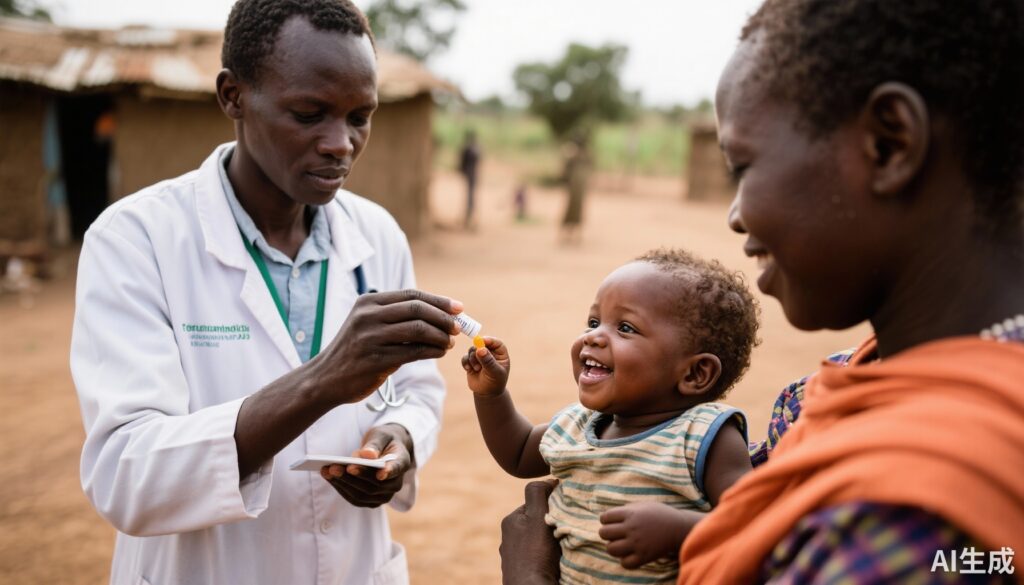Highlight
- Mass administration of azithromycin to infants aged 1 to 11 months in Mali did not reduce mortality compared to placebo.
- The trial randomized 1151 villages to placebo, twice-yearly, or quarterly azithromycin administration, enrolling over 149,000 infants.
- Mortality rates were similar across the three groups with no statistically significant differences.
- Adverse event rates were low and comparable among groups, supporting safety but not efficacy in mortality reduction.
Study Background
Mass drug administration (MDA) of azithromycin has previously demonstrated mortality reduction among children aged 1 to 59 months in some sub-Saharan African settings. These benefits were particularly noted in infants under 12 months, especially within three months of dosing. Azithromycin’s broad antibacterial and anti-inflammatory effects, along with control of certain infections, underlie the hypothesis that periodic MDA could reduce child mortality in resource-limited contexts. However, the durability and reproducibility of such effects remain uncertain, prompting this large trial in Mali to focus narrowly on infants aged 1 to 11 months to test if regular azithromycin dosing reduces early infant mortality.
Study Design
This was a cluster-randomized, placebo-controlled trial conducted in rural Mali from December 2020 to December 2022. A total of 1151 villages were randomized in a 3:4:2 ratio to one of three arms:
- Control: quarterly placebo doses every three months.
- Twice-yearly azithromycin: azithromycin given at two quarterly visits from January through June, and placebo for the remaining two visits.
- Quarterly azithromycin: azithromycin administered every three months year-round.
Eligible infants aged 1 to 11 months received weight-based doses of 20 mg/kg. The primary outcome was death within three months after confirming eligibility, analyzed on an intention-to-treat basis. The trial also monitored adverse events and mortality in older untreated children aged 12 to 59 months.
Key Findings
Over the two-year period, 149,090 infants received at least one dose of study medication, contributing to 82,600 person-years of follow-up. The distribution of villages was 386 in the control group, 511 receiving azithromycin twice yearly, and 254 in the quarterly azithromycin group. Across groups, 968 deaths were recorded.
Mortality rates were:
- Control group: 11.9 deaths per 1000 person-years (reference rate)
- Twice-yearly azithromycin: 11.8 deaths per 1000 person-years (incidence rate ratio [IRR], 1.00; 95% CI, 0.83 to 1.19)
- Quarterly azithromycin: 11.3 deaths per 1000 person-years (IRR, 0.93; 95% CI, 0.75 to 1.15)
Neither treatment arm demonstrated a statistically significant reduction in mortality compared to placebo. This lack of effect extended to untreated children aged 12 to 59 months.
Adverse events were infrequent and similarly distributed among all groups, indicating that azithromycin is safe when administered on this schedule but without evident mortality benefit.
Expert Commentary
This study is the largest and most rigorously designed trial evaluating azithromycin MDA limited to infants under 12 months. Prior studies have suggested transient mortality reductions, but these findings were not replicated here, suggesting that the benefit of azithromycin MDA on mortality may be context-dependent or influenced by underlying disease epidemiology.
Potential reasons for the null results include differences in infection patterns, antibiotic resistance, or secular mortality trends. The trial’s high sample size and cluster randomization offer robustness, though the dosing regimens and timing may still miss critical windows of susceptibility.
This trial underscores the complexity of implementing MDA as a universal mortality reduction strategy and cautions against extrapolating infectious disease control benefits without context-specific validation. Biologically, while azithromycin has broad-spectrum activity, its impact on mortality may be limited to select infections or community contexts with higher baseline bacterial pathogen burden.
Conclusion
The mass administration of azithromycin to infants aged 1 to 11 months in Mali did not reduce infant mortality compared to placebo, regardless of whether dosing was twice yearly or quarterly. These results challenge the generalizability of prior positive findings in sub-Saharan Africa and suggest that policy decisions on azithromycin MDA should consider local epidemiology and rigorously evaluated evidence. Future research should focus on identifying subpopulations or conditions where azithromycin administration might confer benefit.
Funding and Trial Registration
This study was funded by the Bill & Melinda Gates Foundation. The trial is registered with ClinicalTrials.gov under identifier NCT04424511.
References
Haidara FC, Adubra L, Abdou M, Alber D, Ashorn U, Cheung YB, Cloutman-Green E, Diallo M, Ducker C, Fan YM, Gruffudd G, Hallamaa L, Haapaniemi T, Ihamuotila R, Juma J, Klein N, Luoma J, Martell O, Murugesan A, Okello C, Samaké O, Traore CAT, Vehmasto T, Ylikruuvi K, Sow S, Ashorn P. Mass Administration of Azithromycin to Infants in Mali to Reduce Mortality. N Engl J Med. 2025 Oct 16;393(15):1498-1508. doi: 10.1056/NEJMoa2504644. PMID: 41092331.



